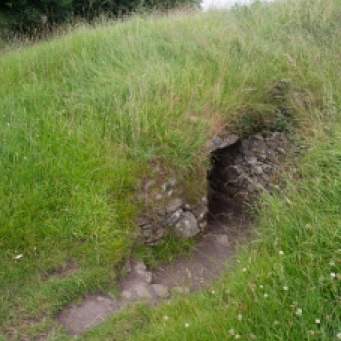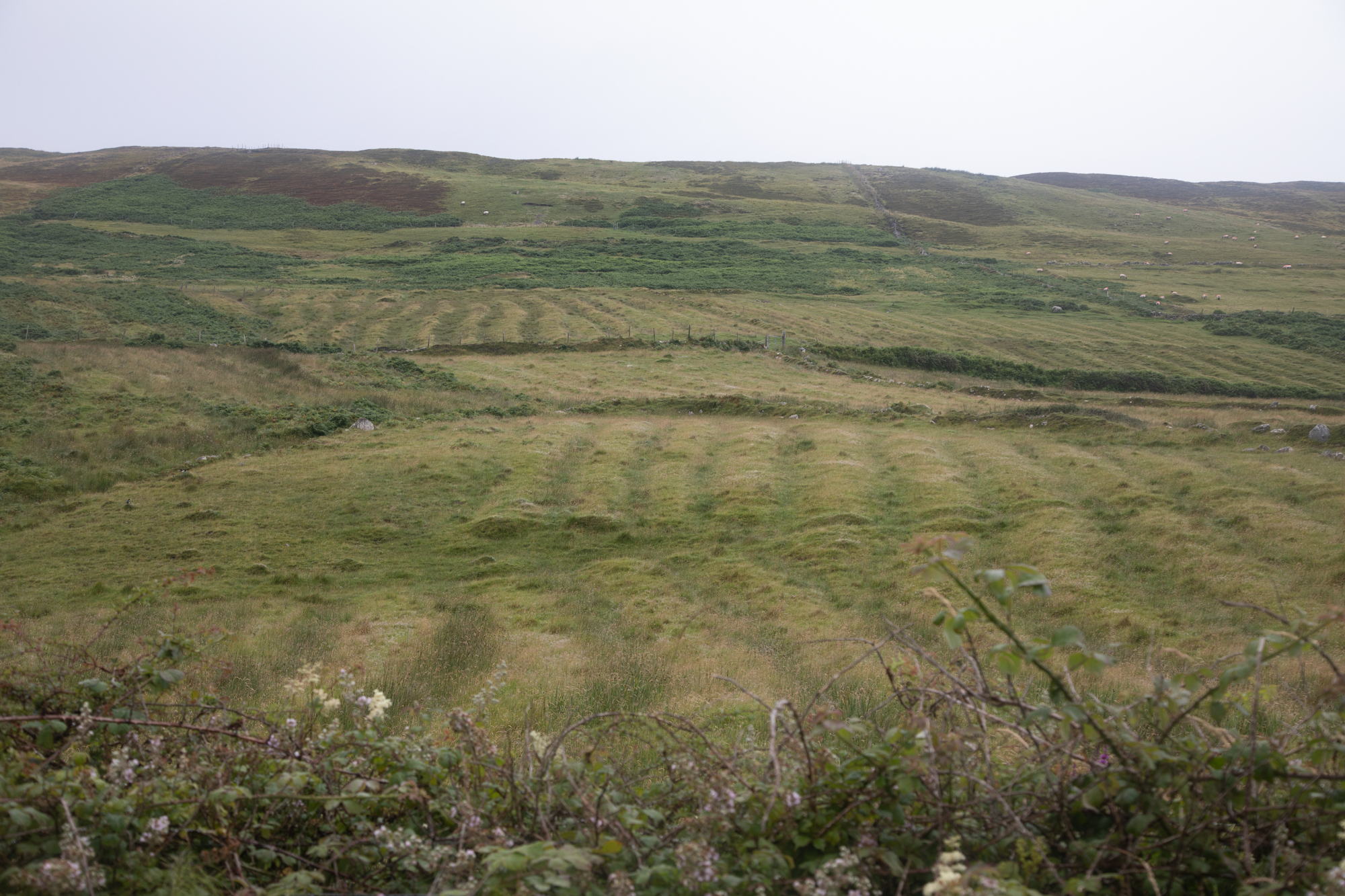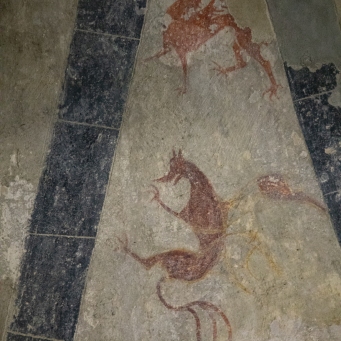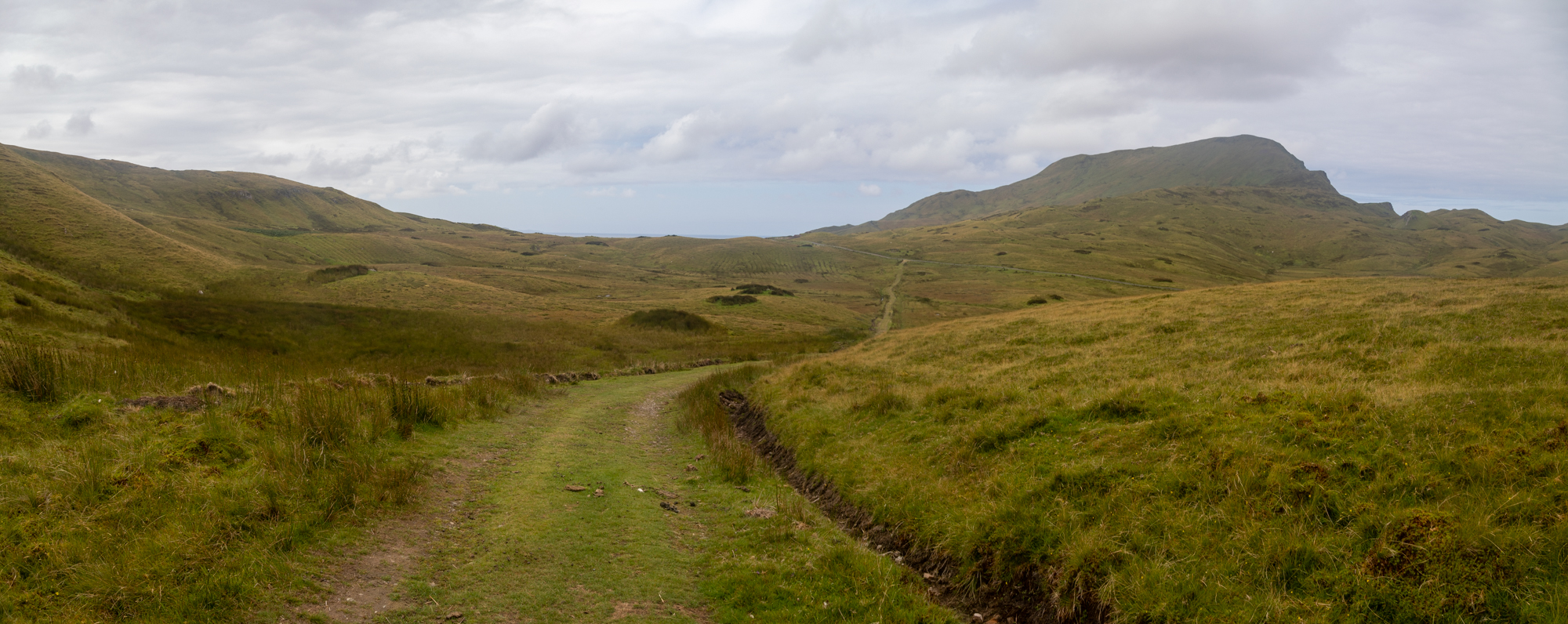
View of Dowth Chapel and Manor, Dowth Castle, Dowth school and the Dowth church
The picture above I took in July 2019. I didn’t realise it at the time but in that one photo I captured eight hundred years of history and the Irish struggle. An history that includes the rise and fall of the great Anglo-Norman families, Oliver Cromwell, J B O’Reilly and the struggle of the Fenians, penal servitude and escape and the diaspora; and as if that wasn’t enough the destruction of a 5,000 year old megalithic treasure. Left to right is the Netterville Chapel, Netterville Manor, Dowth Castle, Dowth school house (the low stone building with the gabled roof) and the ruins of Dowth Church on the far right. Here’s another view.

View of Dowth Manor, Dowth Castle and the Dowth church and graveyard
And a couple of hundred metres to the right, too far away to get into the picture, is the Dowth passage tomb.

Dowth Passage tomb mound viewed from the church.
Let me explain a bit more. Stay with me and I’ll try and keep it brief.
Dowth in Co Meath, lies near the banks of the Boyne River in the famous Bend of the Boyne, where is the world heritage site of Brú na Bóinne and the passage tombs of Newgrange and Knowth. As I referred to briefly, there is also a passage tomb at Dowth. I’ll come back to that, but my story starts with Dowth Castle, the ancestral home of the Netterville family, who were granted the estate in the 13th century.

Dowth Castle. Home of the Nettervilles
In 1641 during the civil war, then Viscount Netterville was declared an outlaw for supporting the Confederates and deprived of his estates. Ten years later he was pardoned by Oliver Cromwell. And then in 1655 another Netterville was imprisoned in Dublin Castle as a traitor but escaped death pleading that he was held by the rebels against his will.
Subsequent Nettervilles displayed all the eccentricities you would expect of these ruling families. The incumbent Lord built a Manor house in 1780 and moved out of the castle. It was complete with elaborate gardens, ramparts and walks around the House and Castle. He built a tea house on top of the passage grave mound and attended mass remotely with the assistance of a telescope focussed on the church. Unfortunately, the Viscount was also unknowingly complicit in the destruction of the tomb. With money he donated to excavate the ruins before his death, members of the Royal Irish Academy in 1849, used, can you believe it, dynamite and destroyed the mound leaving a crater you can still see today. I’d like to think he would have been horrified at what was done.

Crater at the top of the Dowth Mound
While we are talking of the Dowth mound, it is not on the tour agenda of Newgrange, but it is worth visiting separately to get a feel for what they may have looked like in the field. There is no reconstruction here (just destruction it seems!). There were 115 kerbstones of which half are visible. Fifteen are carved including the spectacular Stone 51, known as the Stone of the Seven Suns. Also surviving are two passage entrances.

Some of the surviving visible kerbstones at Dowth mound. Stone 51 is the fourth stone from the right.

Stone 51. The Stone of the Seven Suns.

A drawing of Stone 51 by archaeologist, Martin Brennan.
Back to my story. In 1826, the property was bequeathed for the construction of an ‘alms house’ for aged women [alms houses are a Christian charitable tradition whereby accommodation is provided for poor, old or indigent people]. The magnificent Victorian Gothic red brick structure was built as part of this endowment in 1877 along with the chapel. I particularly love the decoration in the brick and over the windows and doors highlighted with blue bricks.

Part of Dowth Manor Alms House. Beautiful red brick with details outlined with blue brick and limestone.
I’m not sure how long it lasted as an alms house, but it has had a variety of uses since then in the 20th century. During the 1960s the house was the headquarters of the Newgrange excavations (hopefully without dynamite this time). It has been owned by the Hearst Family and was once occupied by a group of Buddhists, and more recently as a venue for weddings and conferences. It was up for sale in 2015 at €2.25 M.
All that is truly fascinating but for me it is the connection of the property with J B O’Reilly that makes it come alive.
John Boyle O’Reilly was a man of his time. A charismatic man who in his short life may well have been the best know Irishman across three continents. He was an Irish hero and made his mark in many fields.
His name was well known to me through his authorship of the novel, Moondyne, an Australian classic, and his involvement in the spectacular Catalpa rescue of Fenian prisoners from Fremantle Jail. What I didn’t know is anything of his life in Ireland and America, which is littered with monumental achievements.
It was only by accident that I stumbled on the connection. After inspecting the passage tomb I was drawn to the ruins of a church a little distance across the paddock. There I discovered a memorial to him at the back of the church. The monument was erected in 1903.

Memorial to John Boyle O’Reilly at the back of the Dowth church.

J B O’Reilly memorial built 1903
It turns out he was born in the tower house, then occupied by his father, a schoolteacher. Indeed the school was next door in a low stone building adjoining the tower house.

The school house at Dowth attended by John Boyle O’Reilly until he was 11. His bust and a plaque are on the wall.
So I brought myself up to speed on his life story. His achievements are many and his impact profound and there is not space here to cover it all but here are a few highlights from his extraordinary life.
- Born in 1844 into the middle of the Irish Famine. Being born into privilege he survived.
- Leaves school aged 11 to take on an apprenticeship as a printer at the local Drogheda newspaper
- Goes to London at 13 to work as a stenographer
- Returns to Ireland at 19 and became a soldier in the British Army
- Soon after he joins the Fenians at the invitation of the IRB and infiltrates the British Army
- Arrested at 21 and sentenced to death for treason. Commuted to 20 years hard labour because of his youth.
- At age 23 he and sixty-one other Fenian prisoners sent to Fremantle, Western Australia.
- At age 24 escapes from Fremantle on a whaling ship. Fakes his own suicide to avoid capture at Mauritius.
- At age 25 arrives in US via London, on the run. Moves to Boston; works for The Pilot newspaper.
- At age 31 becomes owner and editor of The Pilot. It becomes second biggest Boston newspaper after the Boston Globe.
- Becomes a spokesman for Irish immigrants, a well-known poet, orator, sportsman, and activist for political causes.
- At age 31 helps organise the rescue of six Fenians from Fremantle, again using a whale ship, The Catalpa.
- Becomes one of Americas foremost poets.
- At 34 writes Moondyne, a semi-autobiographical novel set in Australia.
- At 35, acknowledged leader of the “Irish cause”
- Dies at 44 from an accidental overdose of his wife’s sleeping pills
Wow! Admired and revered on three continents at the time, his work has been criticised subsequently, especially Moondyne, as presenting degrading portraits of Aborigines and glowing praise for capitalist exploitation by the British empire, with racist overtones. Yet the novel was a landmark. It scoffs at hypocrisy, and deals with redemption for the downtrodden and forgotten in society and among other things offers solutions on the Australian penal system, the Irish land question, and America as a model for the future.
So there it is. A huge part of the story of Ireland reflected in this collection of buildings in a beautiful valley in County Meath. And to think I could have just driven straight past it.



































